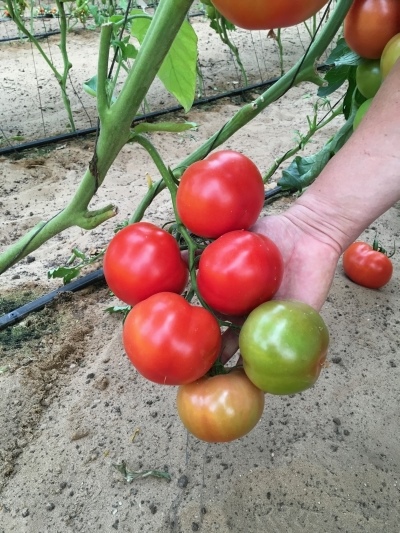
- Authors: Enza Zaden Beheer B.V.
- Year of approval: 2003
- Name synonyms: Belle F1
- Category: hybrid
- Growth type: indeterminate
- Ripening period: mid-early
- Ripening time, days: 107-115
- Growing conditions: for open ground, for film greenhouses, for closed ground, for greenhouses
- Marketability: high
- Transportability: high
The Bellé variety is considered one of the most unpretentious, especially when grown in a greenhouse. A high yield can be achieved even in an unfavorable environment. The bushes tolerate heat and drought without any problems. The lack of sunlight also does not affect the condition of plants and fruits.
Description of the variety
The culture is cultivated in open and closed ground conditions. Growth type is indeterminate. Tall plants, reaching a height of 1.5 meters, have a strong branching and medium foliage. Medium-sized bright green leaves. The form is standard. The root system is well developed, the trunks are strong and thick. Due to the powerful rhizome, the plant receives a sufficient amount of nutrients from the soil.
A moderately dense crown protects the crop from hail and direct sunlight. Vegetables ripen evenly throughout the season. The inflorescences are simple. The first is formed over 9 leaves, and the rest alternate every 3 leaves.
The main qualities of the fruit
As they ripen, the green fruits turn a deep red color. The sizes of the fruits are marked as large and gain in weight from 121 to 145 grams. Often there are specimens of about 180 grams. The shape is rounded, slightly flattened. Ribbing is weak. The fleshy and firm flesh is colored dark red. The skin is smooth, glossy. The keeping quality of the fruit is good.
Tomatoes are the same size. They can easily withstand long transportation and are stored for a long time in boxes. Because of this characteristic, tomatoes are grown commercially.
Taste characteristics
Remarkable gastronomic qualities are noted by both specialists and ordinary summer residents. Mature vegetables make delicious sauce and ketchup. They are perfect for salads and vegetable cuts.
Ripening and fruiting
The ripening period of the variety is medium early and ranges from 107 to 115 days.
Yield
The high-yielding variety pleases with large volumes every year. From one square meter are collected from 27.4 to 31.1 kilograms. On average, about 6 kilograms of tomatoes are obtained from one bush.
The timing of planting seedlings and planting in the ground
The exact sowing time depends on the climate in a particular area. The work is performed in the 2nd or 3rd decade of March. In the northern regions, this is done in early April. Purchased seed material does not need to be processed. Fertile soil for seeds can be prepared by yourself by mixing humus and garden soil. The mixture is moistened. The seeds are deepened by 1.5-2 centimeters, sprinkled with soil and covered with foil.
As soon as the first shoots appear, the container is transferred to a warm and bright place. Lack of sunlight is compensated by lamps. Seedlings are watered when a dry crust appears. Use only warm water. After the formation of several leaves and the first inflorescence, the plants are transplanted to the beds.
Note: when growing seedlings, sowing seeds is performed 60-65 days before transplanting into the ground.

Growing tomato seedlings is an extremely important process, because it largely depends on whether the gardener can harvest at all. All aspects must be taken into account, from seedbed preparation to planting in the ground.
Landing scheme
When laying the landing, they adhere to the scheme of 70x40 centimeters. A sufficient amount of free space is necessary for the full development of the bushes.

Growing and care
The Bellé variety feels great in nutritious and loose soil. This condition plays an important role in the yield of vegetable crops. After choosing a site for the permanent cultivation of tomatoes, the location is prepared. Before planting seedlings, the soil is fed with organic matter: peat, sawdust, humus or compost. The optimum hole depth is 10 centimeters. Each of them is poured with boiling water for disinfection.
The bushes deepen a little, this contributes to the development of lateral roots. The ground around the plants is covered with mulch. With its help, you do not have to loosen the soil every time after each irrigation. Sawdust or peat is widely used. And also a layer of mulch helps maintain the desired level of moisture and is a barrier that protects against bacteria and weeds.
When cultivating Bella, it is important to correctly form a bush into one stem. Excess shoots are removed within 10-12 days after transplanting. Only in the first week after the transfer of young plants to the ground, the bushes are abundantly irrigated. After they switch to moderate watering. Before adding the next portion of water, the earth should dry out a little. Care must be taken to prevent the leaves from withering.
Tomatoes are fed every 14-21 days using mineral fertilizers.
The first portion is applied 2 weeks after planting. The plantation is watered with mullein solution (proportions 1/5).
Three weeks after the first feeding, the second is introduced. In 10 liters of water, 20 grams of superphosphate and the same amount of potassium salt are dissolved.
Boric acid (2 grams per 2 liters) is used during flowering.
As soon as the formation of the crop begins, they switch to potassium-phosphorus compositions.
And also care consists in performing the following activities:
weed removal;
treatment of plants from pests and diseases;
inspection of the bushes.
Note: pour over the tomatoes with warm water.




A plant needs different micronutrients at each stage of growth. All fertilizers can be divided into two groups: mineral and organic. Folk remedies are often used: iodine, yeast, bird droppings, eggshells.
It is important to observe the rate and period of feeding. This also applies to folk remedies and organic fertilizers.



























































































